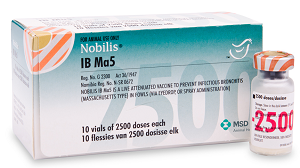Nobilis® IB MA5

A live attenuated vaccine, indicated for the immunisation of fowls against Infectious Bronchitis (IB) (Massachusetts type), via eye drop or spray administration.
For Animal Use Only
NOBILIS® IB MA5
REG. NO. G2300 (Act 36/1947)
NAMIBIA REG. NO. V97/243/822
ZAMBIA REG. NO. 331/706V
ZIMBABWE REG. NO. 2015/80.23.17/9724
NOBILIS® IB MA5 is a live attenuated vaccine to prevent Infectious Bronchitis (IB) (Massachusetts type) in chickens (via eye drop or spray administration).
Storage
- Store in the dark between 2 °C and 8 °C. Do not freeze.
- Avoid prolonged or repetitive exposure to high ambient temperatures.
- Protect from exposure to direct sunlight.
Composition
Each dose of the live freeze-dried vaccine contains Infectious Bronchitis virus strain Ma5 (serotype Massachusetts).
Contents
Each dose of NOBILIS® IB MA5 contains at least 103,5 EID50 Infectious Bronchitis virus strain Ma5 (serotype Massachusetts). The vaccine pellet contains stabilisers and gentamycin.
Warnings
- Do not freeze.
- It is advisable to vaccinate all the susceptible chickens on the farm at the same time. If this is not feasible, strict separation of vaccinated and unvaccinated chickens should be done to prevent the spread of the vaccine virus to the unvaccinated chickens.
- Destroy any unused, reconstituted vaccine, empty vaccine containers, needles, etc. for instance by burning after completion of the vaccination.
- Do not open and reconstitute until ready to start vaccination.
- Use the vaccine immediately after reconstitution.
- Do not store partially used containers for future use.
- Do not mix the vaccine with other vaccines.
- Do not administer simultaneously with other live vaccines.
- Use according to the number of doses as indicated on the label.
- The vaccine is safe for use from day 1 of age onwards. After the first vaccination an adequate immunity against Massachusetts type IB will last approximately 6 weeks, provided the vaccine is properly administered.
- Emergency vaccination during the laying period may be accompanied by a transient drop in egg production.
- Do not vaccinate within 21 days of slaughter.
- Keep out of reach of children and uninformed persons.
- Although this vaccine has been extensively tested under a large variety of conditions, failure thereof may ensue as a result of a wide range of reasons. If this is suspected, seek veterinary advice and notify the registration holder.
Precautions
- Vaccinate healthy chickens only.
- If the spray method is used for the administration of the vaccine, ensure that there is no iron, chlorine or disinfectants in the water.
- The spray apparatus should be free from sediments, corrosion and traces of disinfectants. It should preferably be used for vaccination purposes only.
- Avoid contamination with traces of disinfectant and / or spirits.
- Wash and disinfect hands and equipment after vaccination.
- It is good vaccination practice to avoid contact with the eyes, hands and clothing when handling the vaccine.
Directions for use
- Use only as directed.
A. Spray Method
The vaccine should be dissolved in cool, clean, non-chlorinated water which is free from iron and chlorine. The vial of freeze-dried vaccine should be opened under water. The spray apparatus should be free from sediments, corrosion and traces of disinfectants (preferably to be used for vaccination purposes only).
The vaccine medicated water should be spread evenly over the correct number of chickens, at a distance of 30 – 40 cm, preferably when the chickens are sitting together in dim light.
For day-old chickens use 0,25 litres of water per 1 000 birds and set nozzle to produce fine droplets, falling like a fine rain. For older chickens, dissolve 1 000 doses per litre of water and set the nozzle to produce fine droplets (Aerosol generators should be used only when this is known to be safe to chickens).
B. Eye Drop Application
Dissolve the vaccine in Diluent Oculo-nasal and administer by means of a standardised dropper (usually 35 mℓ per
1 000 doses). One drop should be applied from a height of a few centimetres onto one eye. As an eye drop application, the drop should be allowed to spread evenly across the surface of the eye.
Do not release the fowl until a swallowing motion is noticed.
For numbers of birds between standard dosages, the next high dosage should be chosen.
Vacination program
The optimum time and method of administration depend largely upon local situation. The advice of a veterinary surgeon should be sought. The vaccine is safe to use from 1 day of age onwards.
Guidelines
Broilers: Vaccination at day old by coarse spray or eye drop route.
Layers and Breeders: Vaccination at day old by coarse spray or eye drop route.
Revaccination: At approximately 6 weeks of age by coarse spray or the eye drop methods.
Immunity and Vaccination Reaction
The duration and intensity of the vaccination reaction and the establishment of a solid immunity are generally dependent on the health and condition of the chickens. Hygiene and management are also important in the post vaccination period.
After a first vaccination an adequate immunity against Massachusetts type of IB will last for approximately 6 weeks, provided that the vaccine is properly administered. Emergency vaccination during the laying period may be accompanied by a transient drop in egg production.
Presentation
Vials containing 1 000, 2 500 or 5 000 doses.
Registration Holder
Intervet South Africa (Pty) Ltd.
20 Spartan Road, Spartan, 1619, RSA
Tel: +27 (0)11 923 9300
Fax: +27 (0)11 392 3158
www.msd-animal-health.co.za
